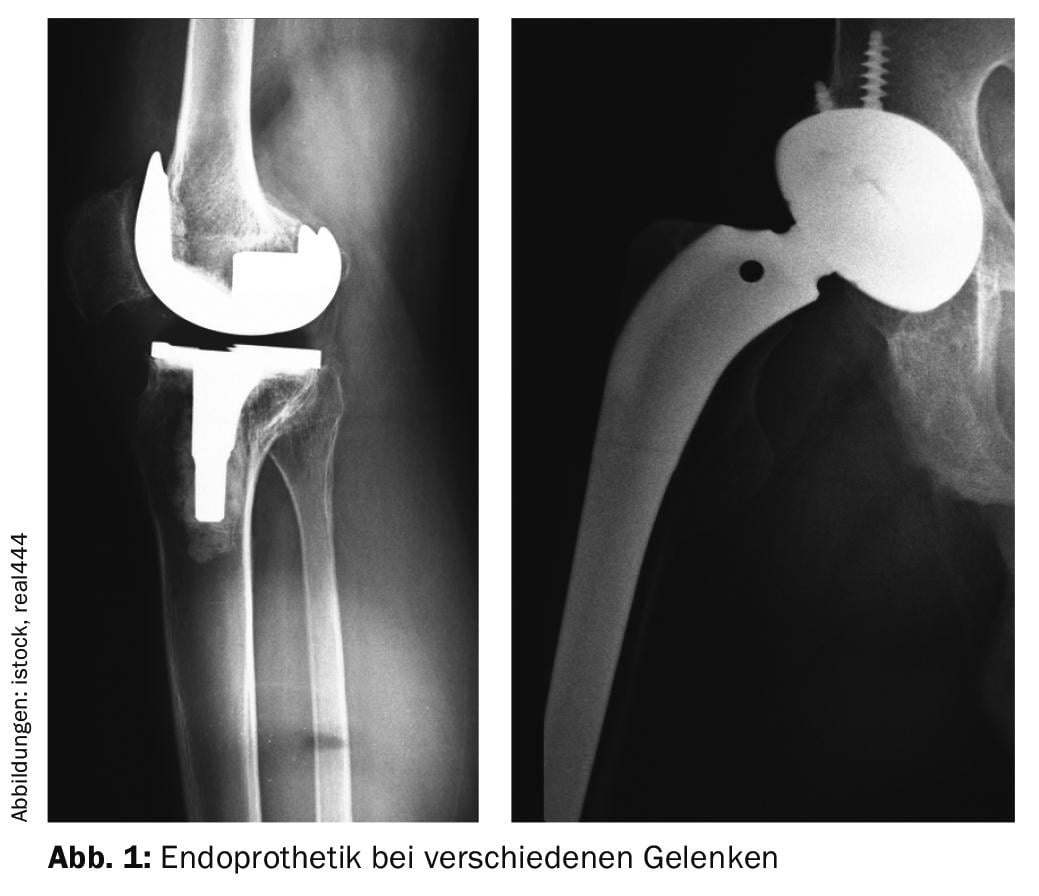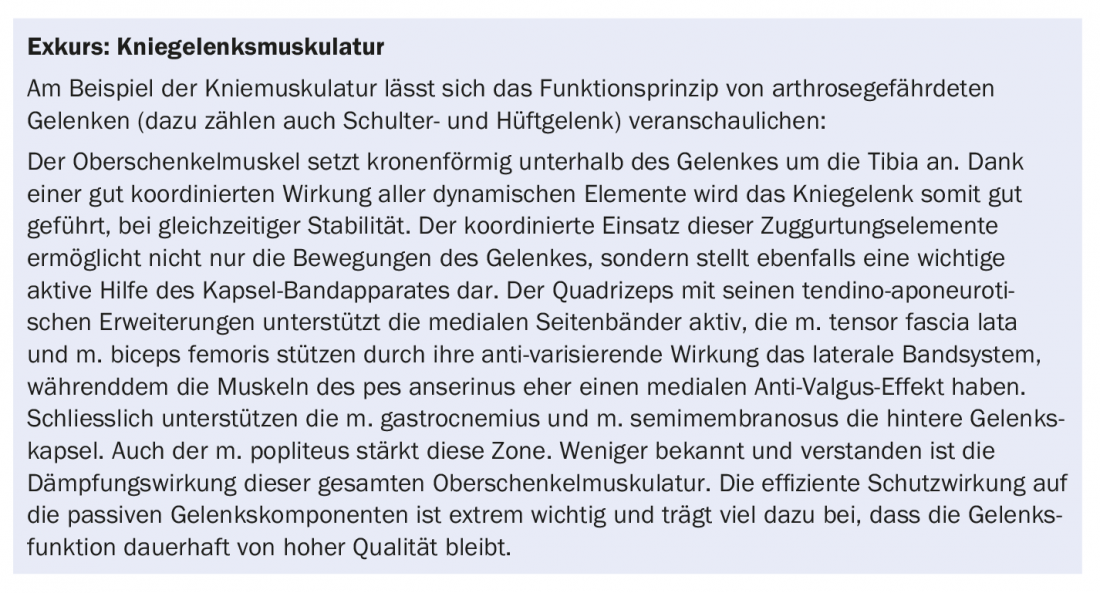Those who train their muscles appropriately as they age are less susceptible to degradation processes. Sometimes, however, joint damage necessitates artificial joint replacement. The good news is that exercise is still possible and beneficial to health, provided certain factors are taken into account.
As stated in the first part of this series of articles in HAUSARZT PRAXIS 11 [1], sport of moderate intensity and exertion is an important factor in the prevention, therapy and rehabilitation of osteoarthritis. With increasing age, there can be a reduction in muscle strength with corresponding consequences on movement execution, stabilization and damping functions (up to sarcopenia). These age-related changes can be explained, among other things, by a reduced protein synthesis and a reduction in the number of fibers and occur to a greater extent in patients who reduce their physical activity due to osteoarthritis.
Sport can positively influence age-related degradation processes
It is assumed that after the age of 40 an annual loss of strength of 1% can be expected, which means 20% at the age of 80. This illustrates an age-correlated increase in the joint’s susceptibility to pathologic changes. Studies and empirical data show that individuals with well-trained thigh muscles are less likely to develop gonarthrosis [2]. These positive effects of sport in the context of prevention show that regular exercise is an influencing factor in the multifactorial structure of osteoarthritis. Despite age-correlated degradation processes, the musculature can be trained into old age, although some aspects must be taken into account. Targeted strength training under expert guidance for several months is an important element of conservative osteoarthritis treatment. The physiotherapeutic treatment goals are firstly to control pain and any swelling and restricted movement (“Range of Motion”, ROM) and secondly to train the musculature through strengthening, stretching and coordination exercises so that it is able to take over the functions of movement execution, stabilization and damping. At this point, the so-called arthrogenic muscular inhibition should be mentioned – a pain-related brake against efficient training.
The cooperation between the treating physician and the physiotherapist (who can also fulfill an important motivational function) is of central importance. The physician prescribing physical therapy should determine the goals of treatment and the patient should be able to perform the training as independently as possible without the use of expensive, complicated equipment. Regular exercise is important for stimulating myofibrils, and training the muscles is a process that requires a longer period of time. Motivation and discipline on the part of the patient are important factors. It has been scientifically proven that an exercise program meeting these criteria not only has a positive effect on the musculature, but also contributes to an improvement in the patient’s general state of health [3].
The example of knee joint arthrosis clearly shows that there is a connection between muscle strength and arthrosis. Knee joint osteoarthritis correlates with decreased thigh strength, and this in turn can be a consequence of pain-induced relieving posture. Strength training can have a positive effect on the thigh muscles – it is therefore an important measure in the conservative treatment of gonarthrosis. A review of the anatomy of the knee joint musculature is informative in understanding the important role of the musculature (box).
Surgical treatment options
While not all patients with osteoarthritis are treated with extensive conservative therapy, it would also be naïve to believe that exhausting these non-surgical measures will lead to success in all cases. There are also therapy-resistant symptoms in this area for which surgical options should be considered. Specifically, the following surgical options are generally available for osteoarthritis:
Arthroscopic lavage / debridement
- “Resurfacing.
- Osteotomies
- Arthrodesis
- Endoprosthetics
Arthroscopic lavage/debridement is also called joint toilet. The evidence regarding long-term outcomes is inconsistent. First, there are publications that conclude that debridement does not lead to better outcomes than placebo surgery [4]. However, there are also studies that reach a different conclusion, according to which the treatment of debridement in gonarthrosis leads to good long-term results [5].
For the hip joint, surface replacement surgery, also called “resurfacing,” is an option. In contrast to standard prostheses, only the diseased superficial parts of the joint are removed in this procedure; the femoral head and neck are retained. The “crowning” of the femoral head is done with a metal cap, which – like the thin-walled cup – is made of a special cobalt-chromium-molybdenum alloy, which in individual cases has remained for more than 30 years without relevant abrasion or signs of loosening. As advantages over total prosthesis it is worth mentioning that there is no significant change in leg length and leverage for the hip muscles, the “feeling” for the joint (proprioception) is hardly affected and that the almost natural size of the implants often allows a natural range of motion and provides a high degree of dislocation safety.
Especially in cases of knee joint arthrosis, the so-called conversion osteotomy or corrective osteotomy are used. This corrects malpositions in the area of the leg axis or relieves a partially worn joint. This is something that is targeted in osteoarthritis. The most common osteotomy on the leg is that on the upper part of the lower leg (“high tibial valgization osteotomy”, HTO): Cartilage damage to the inner part of the knee joint slowly leads to the development of a bow leg. With osteotomy, the load is transferred from the cartilage-damaged, painful inner side of the joint to the healthy outer side. This results in a minimally pronounced X-B setting. The aftercare is similar to that for a surgically treated leg fracture, i.e. the patient is only allowed to put partial weight on the joint for a few weeks.
Arthrodesis is a surgical fusion of a joint. The ability to move in the joint is thereby completely prevented. This procedure is used less and less, most often still in the ankle area. The possibilities for sports activities are understandably limited after such a procedure.
By far the most common surgical treatment measure today is endoprosthetics (Fig. 1). The figures speak for themselves: the Swiss implant register SIRIS states that 20,000 hip prostheses and 16,000 knee prostheses are implanted every year – and the trend is rising. For unknown reasons, this registry does not report figures for shoulder and ankle prostheses, which are also becoming more common, but these artificial joints are also being used more frequently.

The reasons for this clear trend are many: prosperity, which allows such not cheap – but quite profitable – interventions, constant aging of the population, interest in sports activities after working life, rapid treatment results compared to conservative therapy, high satisfaction rates, on average good results of this surgical method and others. In addition, the progress made in this field in recent years also explains the popularity for joint replacement – even at a stage when the pain is still bearable but mobility, radius of life and quality of life in general are significantly reduced.
Sport possible despite artificial joint
The question of whether and – if so – which sports are practicable after endoprosthetic joint replacement is of great relevance to the patient and a clear answer is expected from the treating physician. But it should also be clear that there can be no clear answer with validity for all patients and all prostheses on all joints. The following comments are therefore findings and empirical values that must be put into perspective with regard to the respective context:
The most common fear, even today, is that artificial joints become loose through exercise and show signs of wear more quickly. This is not scientifically proven. However, many studies show that not exercising is rather not beneficial to health. Thus, lack of exercise is not least a cause of osteoporosis [6], which endangers the anchoring of the artificial joints in the bone.
Thus, sport could have a beneficial effect and possibly even prolong the wearing time of the artificial joints. In addition, lack of fitness is a common cause of falls and broken bones. Even stumbling puts more stress on artificial joints than most sports. A prosthesis is best protected when trained muscles and tight ligaments surround it. For this reason, patients who have undergone surgery should be more cautious during the first six months after the operation and use this time for physiotherapy and muscle-building training. After that, there is hardly anything standing in the way of a sporting activity.

Well-suited are more or less the same sports that were already mentioned in the first part of this article series [1], so-called “low-impact” sports that do not stress the artificial joint by sudden impacts, permanent load peaks, abrupt rotational movements or extreme abductions. When choosing a sport after arthroplasty, experience and competence in a sport as well as general physical condition naturally play a central role. If someone was a competitive skier before a surgical procedure, alpine skiing is by no means impossible, while it makes little sense to choose a sport never practiced before the procedure. What is very important is that each patient must be advised individually and regardless of the chosen sport, rehabilitation comes first – and this may well take around six months.
Literature:
- Jenoure P: Sport as a risk and protective factor, sport and osteoarthritis, part 1. Family Practice 2018; 11: 5-6.
- Quintrec JL, et al: Physical exercise and weight loss for hip and knee osteoarthritis in very old patients: a systematic review of literature. Open Rheumatol J 2014; 28(8): 89-95.
- Stensrud S, Roos EM, Risberg MA: A 12-week exercise therapy program in middle-aged patients with degenerative meniscus tears: a case series with 1-year follow-up. J Orthop Sports Phys Ther 2012; 42(11): 919-931.
- Laupattarakasem W, Laopaiboon M, Laupattarakasem P, Sumananont C: Arthroscopic debridement for knee osteoarthritis. Cochrane Database Syst Rev 2008; (1): CD005118. doi: 10.1002/14651858.CD005118.pub2.
- Yilar S, Yildirim OS: Early and Late-Term Results of Arthroscopic Surgery on Patients with Gonarthrosis. Eurasian J Med 2014; 46(2): 102-109.
- Chastin SF, Mandrichenko O, Helbostadt JL, Skelton DA: Associations between objectively-measured sedentary behavior and physical activity with bone mineral density in adults and older adults, the NHANES study. Bone 2014; 64: 254-262.
HAUSARZT PRAXIS 2018; 13(12): 6-8











